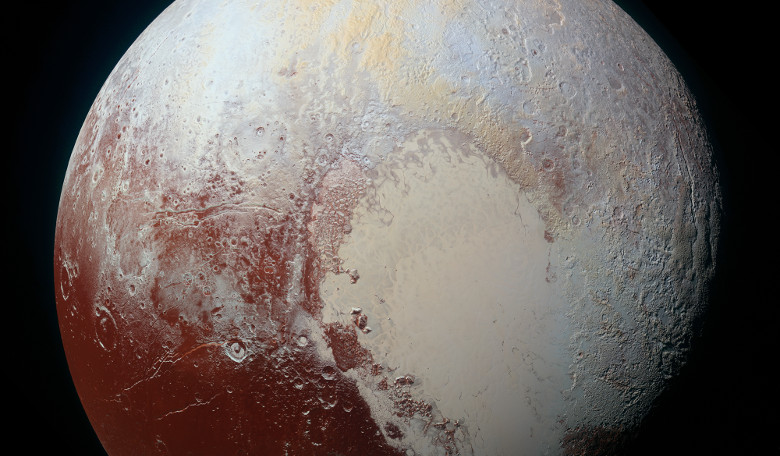Clues to Pluto’s origin could lie in its frozen heart as researchers studying the nitrogen-rich ices in Sputnik Planitia suggest that the dwarf planet may be made-up of roughly a billion comets that are similar in composition to 67P/C-G, the comet surveyed by Rosetta.
Pluto’s small size and unusual orbit has always earmarked it as something of an oddball amongst its larger planetary companions (hence its downgraded status to that of a dwarf planet) and trying to study its chemical history has always been challenging due to the lack of relevant data.
However data from the New Horizons and Rosetta missions have changed all of that and two researchers, Christopher Glein and J. Hunter Waite from Southwest Research Institute, San Antonio have been analysing the nitrogen content in the western lobe of Pluto’s “heart” – the near-equatorial region called Sputnik Planitia – to deduce how Pluto was formed.
Solid molecular nitrogen (N2) appears to be the most abundant ice on the surface of Pluto, but the low surface temperatures on the dwarf planet (~40 K or -233 celsius) means that the ice is able to deform and flow like a very, very slow moving river. This keeps areas such as Sputnik Planitia looking smooth and youthful, but where did all of this nitrogen come from?
The duo suggest that instead of forming from cool ices with a chemical composition closer to that of the Sun – a scenario known as the ‘solar model’ and a model favoured by many to explain Pluto's origin, the nitrogen atoms in the N2 observed on the dwarf planet were accreted in that chemical form during the formation of Pluto. This means that they were brought to the dwarf planet by external sources, such as cometary impacts and not produced on the planet through chemical reactions with other substances.
This theory stems from Glein and Waite's estimates of the amount of nitrogen inside the glacier, which is consistent with the amount that would be expected if Pluto was formed by millions upon millions of comets or other Kuiper Belt objects smashing together.
Nitrogen is expected to be a significant constituent of icy bodies orbiting far out beyond the giant planets, but its existence in a comet was only confirmed just a few years ago when ESA’s Rosetta spacecraft rendezvoused with comet 67P/Churyumov-Gerasimenko and made the first in situ measurement of the compound.
One sticking point to the theory is that if Pluto was formed by the accretion of a billion comets, then it should have an abundance of carbon monoxide (CO) too, but a study of the planet indicates a lot of CO seems to be missing – from its surface at least. To account for this anomaly, Glein and Waite suggest the lack of CO is the result of chemical modification by liquid water, and that the missing CO could be hidden away in a subsurface ocean. It would not be the first time though, that researchers have postulated that a subsurface ocean exists under Pluto’s icy crust.
The jury is not out completely and Glein and Waite do state that the solar model is still a viable option for Pluto's formation, however, the data also fits their evolution theory too, so a further analysis of the original molecular carrier of the nitrogen atoms will be needed to definitively tie down the true nature of this curious dwarf planet.











